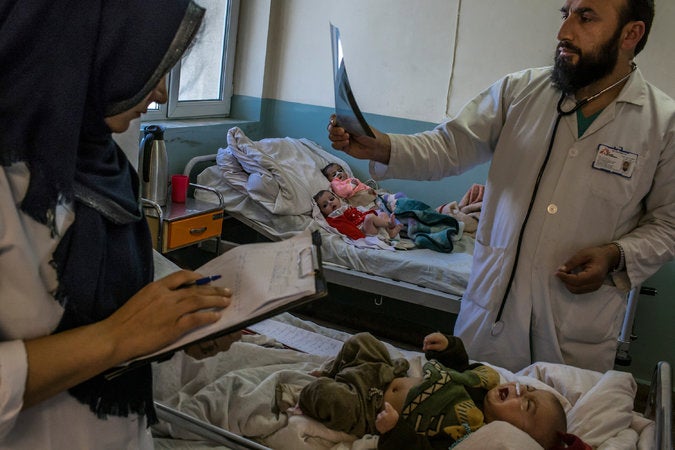
A survey in Afghanistan last year found that an incredible 18% of the 800 respondents – patients at Médecins Sans Frontières (MSF) hospitals in four different parts of the country – reported that in the course of just the previous year (2013), a friend or relative had died because they could not access health care. As the MSF detailed in its report, the top reasons for lack of access were cost, distance, and insecurity.
Besides the sheer human toll and indictment of the health system (and security situation), this was shocking because it wasn’t what we were being told. And therein is an important lesson as we approach the launch of the Sustainable Development Goals, and the reasons we need good data. And it isn’t just for monitoring progress. It’s for making progress.
But first, back to Afghanistan.
The international community had a shared narrative of success in expanding access to health care in Afghanistan, from 9% in 2001/2002 to 85% by 2008, as both USAID and the World Bank (p. 18 and endnote 60) had been reporting.
This claim persisted at least until MSF’s 2014 report (it is no longer present on the World Bank webpage to which MSF cites; indeed, health care access is not listed as an indicator among the Bank’s wealth of indicators). The source of this information may have been a conflation of actually having access to health care and the proportion of districts – 85% – with a district health facility. At the time this claim was being made, Afghanistan’s acting health minister in 2010 cited a survey that put access at 60%.
This discrepancy between the reality and the official statistics takes on heightened importance this month, as world leaders convene at the United Nations to agree to the Sustainable Development Goals.
I wrote last month about how to measure access to health care. Even if we can agree on that, though, there is the question of the quality of the data. It may be confused to the point of becoming highly misleading, as with Afghanistan. It may also be quite inaccurate. Getting accurate maternal mortality data can be notoriously difficult, for example. And depending on whether one trusts householders surveys, an official country estimate, or joint WHO/UNICEF reporting, DTP3 vaccine coverage in Guinea (2012-2014, before Ebola’s effect on immunization programs) ranges from about a meager 50% to an improbable 103%.
Or consider this on poverty: At least as of last year, the poverty figure for Botswana was an extrapolation from data collected in 1993. Most data collected to monitor the Millennium Development Goals was missing, estimated, or based on models.
This brings us to the Sustainable Development Goals (SDGs). To be formally endorsed this month at the United Nations, the SDGs were effectively finalized in early August. With 17 goals and 169 targets, careful monitoring – requiring good data – is especially important to hold governments accountable. It would be all too easy for some targets to get lost in this expanse of commitments. Afghanistan reminds us why we need accurate data: According to Afghanistan’s acting health minister in 2010, when seeking health funds from the finance ministry, the response was: ““You don’t need the money, you are well off.’” And “‘[d]onors tell us ‘you are so successful. You have reached 85 percent of the population. You don’t need additional resources.’”
The Afghanistan case highlights the life-and-death consequences of accurate information, with the effect of information on funding decisions. But more routinely, accurate information is vital for another reason: accountability.
Over the past years, we heard a lot about monitoring the Millennium Development Goals, with prominent, annual UN reports. I expect we’ll hear the same in the years ahead regarding monitoring the SDGs, and measuring progress. The SDG declaration will promises monitoring processes aimed at improving progress towards these goals and targets. I hope, though, that we hear about another sort of monitoring: monitoring accountability processes for the SDGs.
It is one thing to see the data, another to act on it. Accountability processes from a human rights perspective mean not merely explaining progress (or lack thereof), but changing what shouldn’t be. It begins with accurate information on progress, but extends to analysis of any failures in progress, adjusting strategies and investments to respond to those identified obstacles, and acting anew, with improved approaches and investments. And repeating this cycle regularly. All requiring good data, actionable data, granular data that tells a full and true a story as possible.
Monitoring and evaluation — M&E — is important. But M&E&A – monitoring and evaluation and accountable action – is what is really important. That link between data and action is where data can actually transform people’s lives. The action that must be part of the M&E process is the foundation for accountability to the SDG commitments.
So here’s to investments in accurate, timely, disaggregated data. And to annual UN reports — and the other SDG review processes, such as the High-level Political Forum on Sustainable Development — on monitoring not only progress towards the SDGs, but also directly monitoring the robustness of the accountability processes for the SDGs — to going beyond routine M&E, to routine M&E&A.



